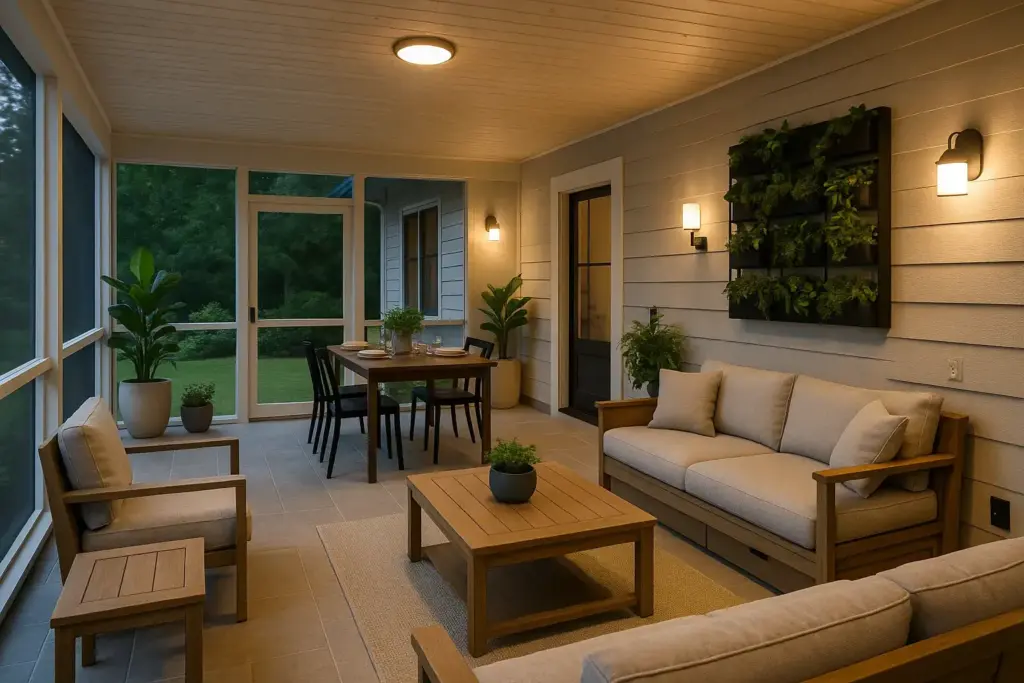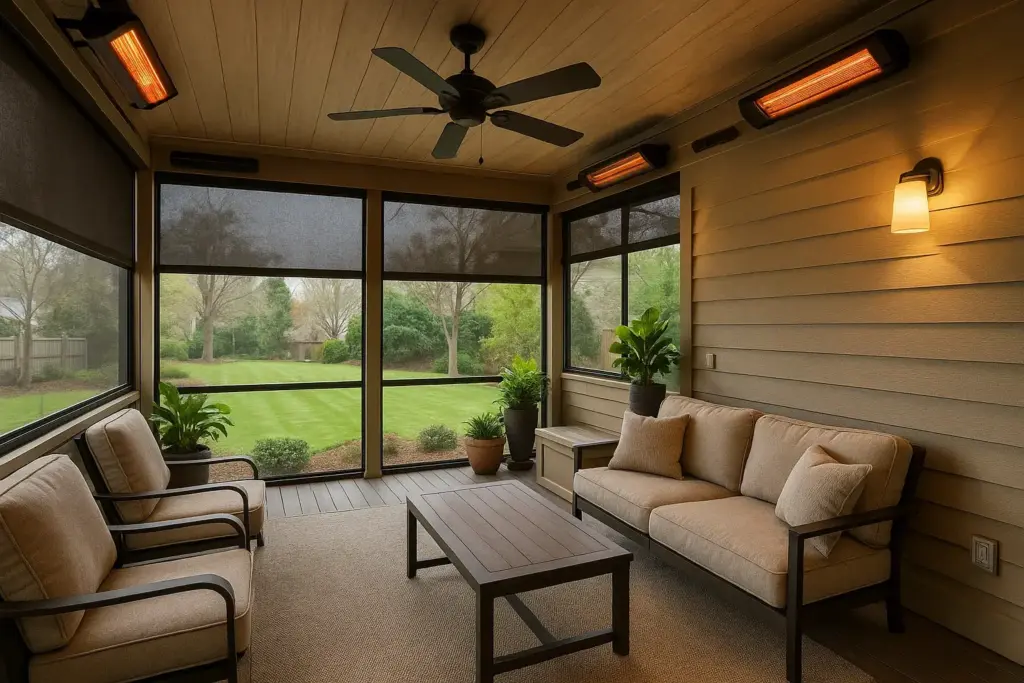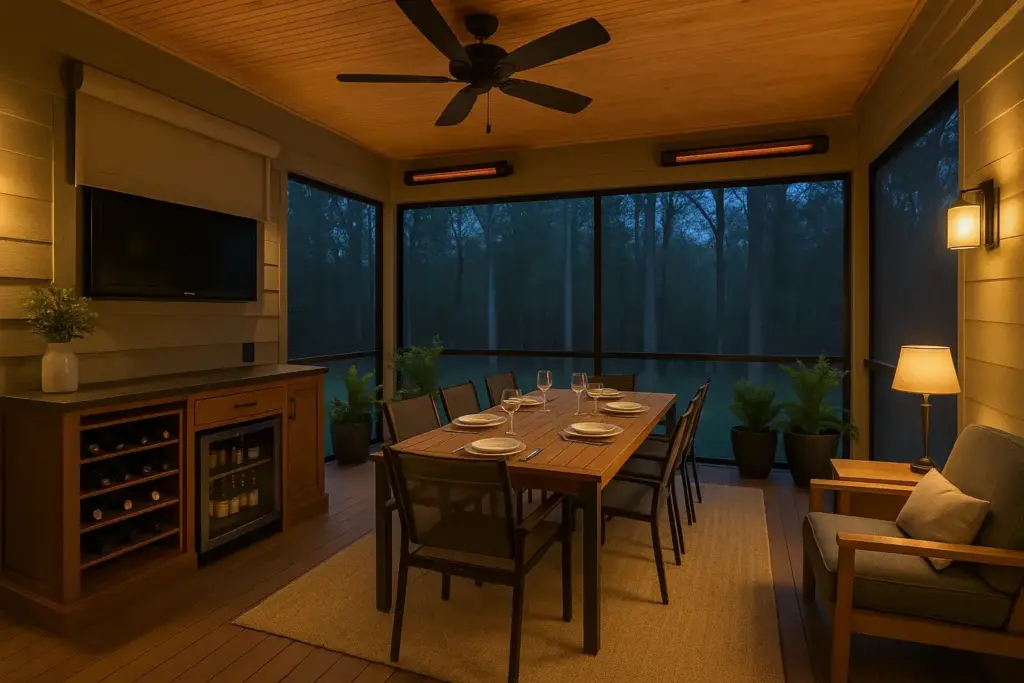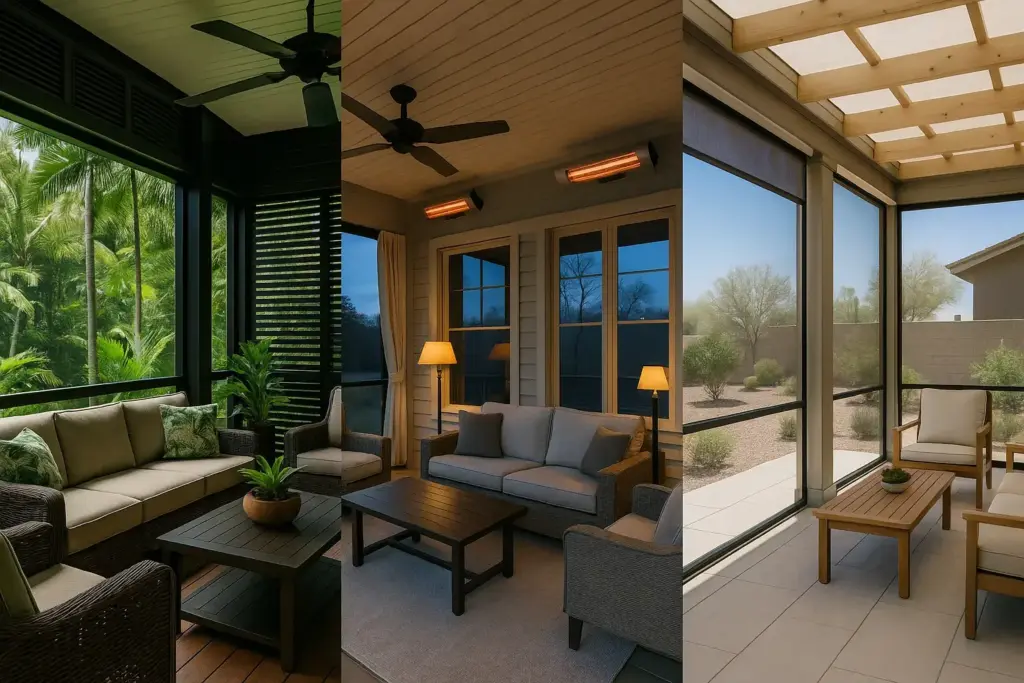Tired of outdoor plans getting cut short by weather or bugs? A screened-in porch fixes that. It’s covered, comfortable, and works in every season, rain or shine.
You stay dry, keep the insects out and still enjoy the fresh air. Add a few smart features, and it’s perfect for morning coffee, family dinners or relaxed evenings with friends.
In this guide, you’ll learn how to plan your layout, pick materials that hold up in any weather, keep things comfortable year-round and style your space to feel like part of your home. You’ll also find practical screened porch ideas to help turn your backyard screen enclosure into a space you’ll use.
Let’s get started and build a spot that works every day of the year, not just when the sun’s out.
Why Go for a Screened-In Porch?
There’s a good reason many homeowners are adding screened-in porches to their outdoor spaces. They offer the best mix of fresh air and everyday comfort, without the downsides of bugs, harsh sun or sudden weather changes.
Let’s take a look at the benefits:
- Better than an open patio: You’re no longer at the mercy of mosquitoes, flies or sudden downpours. A screened porch lets you enjoy your morning coffee or host friends without swatting insects away or running inside when the weather turns.
- More affordable than a sunroom: While sunrooms require full foundations, insulated glass and HVAC connections, screened-in porches are far more budget-friendly. You can create a beautiful, enclosed space for a fraction of the cost.
- Perfect for all seasons: Add a ceiling fan for summer breezes and a space heater for chilly months. Then the porch will stay comfortable throughout the year. Some homeowners even use vinyl or retractable panels to block wind or trap warmth during colder seasons.
- Adds long-term value: A well-designed screened porch increases the livable space of your home, which often boosts its resale value. Buyers appreciate the idea of a separate corner to relax, unwind or entertain without stepping too far from the comforts of indoors.
Before you start decorating, it helps to get the layout right. Here’s how to set up your porch so it’s easy to use and comfortable all year.
Layout Planning for Comfort and Function
Good layout planning for your screened-in porch ensures that the space feels natural to use, so you and your loved ones stay comfortable in every season. The way you arrange things affects your mood and sets the tone for everything else.

But how do you do it? Let’s find out below.
Think in Zones: Dining, Lounging, and Greenery
You can create defined areas for different uses to make the most of your space. A lounging zone with cushioned chairs or a corner sofa works well near the view. And a small dining set closer to the door makes serving easier.
Also, don’t forget greenery. Potted plants or vertical gardens soften the look and make the space feel luxurious and welcoming. And use outdoor rugs to visually separate each zone.
Plan Traffic Flow and Entry Points
No one wants to sidestep furniture every time they enter or exit. Leave at least 90 cm of clear walking space between zones. Besides, placing entry points in logical spots, ideally near the kitchen or main living area indoors, will ensure that you can carry food or drinks seamlessly.
And if you are using screen doors or sliding panels, be mindful of how doors swing open.
Map Out Lighting and Electric Access
Comfort usually comes down to small details like where lights or plugs are located. Make room for overhead lighting or wall lamps, but also plan outlets for fans, chargers or even a mini fridge.
Additionally, you can add a dimmer switch if you want more control over the mood, especially in the evenings.
Include Seasonal Storage
Think ahead to where you’ll put cushions, blankets or outdoor candles during off-seasons. Built-in benches with hidden compartments or waterproof storage chests work well without cluttering the space.
Hooks or shelves along the wall can also hold throws, lanterns or gardening tools.
Pro Tip: Drawing from our experience, sketching out your furniture placement first helps avoid regrets later. Visual planning reveals pinch points and lets you test different arrangements without lifting a thing.
Seasonal Comfort: Heating, Cooling, and Ventilation
Seasonal comfort means designing your porch so it’s enjoyable on the hottest summer afternoon or during a chilly winter morning. With the right planning of ventilation, heating and cooling features, you can turn your backyard screen enclosure into a true four-season retreat.
Temperature Control Options
Adding smart heating and cooling elements means you’ll use the porch more often and enjoy it longer into the year. The right combination can be done this way:
- Ceiling Fans: Outdoor-rated ceiling fans help move warm air out and pull cooler air in. This creates a wind effect, which can lower the perceived temperature by several degrees. Many models come with remote control or reversible motor features for use during winter, too. You’ll have to pay around $120 to $250 for these fans, including installation.
- Infrared Heaters: These heaters provide directional warmth. They heat people and furniture rather than the air, and they are energy-efficient and perfect for winter evenings. Wall or ceiling-mounted models don’t take up floor space and usually include adjustable settings. Their prices start at $200 and can go up to $500 depending on the coverage area.
- Passive Ventilation: This includes features like open gable ends, screened transom windows or louvres that let hot air escape and cooler air enter. Passive ventilation needs no electricity. And when they are designed well, passive airflow can regulate temperature naturally. It’s ideal for reducing costs and maintenance in the long term.
Add Insulation Underfoot
The floor plays a significant role in temperature control. Insulating from underneath keeps things warmer in winter and cooler in summer.

- Thermal Rugs or Mats: These act as a cosy barrier between your feet and a cold floor. They’re ideal during colder months and also add visual warmth to the space. Choose materials rated for outdoor conditions to avoid mould or mildew. And for the price, a decent-sized thermal outdoor rug costs between $80 and $150.
- Insulated Flooring: Installing composite decking over insulation panels helps maintain a more stable surface temperature. This setup prevents heat from escaping in winter and reduces the heat transfer from hot surfaces in summer. It can add $600 or more to your build, but it’s worth it if year-round use is a priority.
Energy-Efficient Shades
These flexible upgrades help regulate temperature and light without taking up much space. They’re one of the easiest ways to boost all-season comfort.
- Retractable Shades: These shades offer on-demand temperature control by blocking direct sunlight during the day and providing insulation at night. Their motorised versions allow you to adjust coverage with the push of a button. On the other hand, solar fabric options help reduce UV damage to furniture. Their prices start at $300 and vary by size and features.
Climate-Specific Tips
Your local weather has a hand in how your porch should be set up. Adjusting it to your climate keeps it functional irrespective of the season.
- Hot Regions: Use cross-breeze layouts by positioning openings on opposite walls. Add light-coloured shades to reflect heat and install misting systems to cool the air. Also, keep seating in shaded zones, and avoid dark flooring that absorbs heat.
- Cold Climates: Install insulated curtains, use radiant heaters and enclosed flooring. Heavier textiles, thermal rugs and sealed window panels can retain heat effectively. And position your seating near heat sources for maximum comfort.
- Coastal Homes: Prioritise corrosion-resistant materials like stainless steel for fixtures and marine-grade fabric for cushions. Plan for strong airflow with large screened openings to prevent stale, damp air from settling. And your furniture and features should be easy to wipe down due to high humidity and salt exposure.
Durable Materials That Last All Seasons
Comfort and climate control matter, but your screened-in porch also needs to hold up against the elements. Rain, sun, humidity and cold can all wear down poorly chosen materials. That’s why durability matters.
Using the right materials ensures your space looks good, functions well and lasts for years with minimal maintenance. Let’s look at smart material picks that fit all seasons and keep your screened porch ideas low-effort yet long-lasting.
Flooring Options
Your flooring faces constant exposure to weather changes, spills and foot traffic. It needs to be strong, easy to clean and resistant to moisture.
Two standout choices balance beauty and long-term performance, and here they are.
Treated Wood
Pressure-treated timber is a classic choice for porches. It’s widely available, resists rot and insects, and can be stained or painted to suit your style. However, it does need occasional sealing and may suffer over time. You’ll need to pay around $100 to $150 per square metre for materials and installation.

Composite Decking
Made from a combination of wood fibres and recycled plastics, composite boards resist moisture, warping and fading. They require almost no preservation and last far longer than timber. It costs a bit more upfront, roughly $180 to $250 per square metre, but pays off in lower maintenance over the years.
Screening Choices
Screens are what separate a screened-in porch from a patio. They protect you from insects and filter light and breeze. Picking the right screen depends on your climate, how much sun exposure you get and how much wear and tear you expect.
Fibreglass
This is the most common screen material. It’s flexible, budget-friendly and doesn’t crease easily during installation. While it’s not the strongest option, it’s perfect for light-use areas. Costs start around $1.50 per square metre.
Aluminium
Aluminium screens are stronger and more durable than fibreglass. They’re great for areas with pets or high traffic. However, they can dent or crease if hit hard. Their pricing sits at about $2.50 to $3.50 per square metre.
Solar Mesh
This specialty screen blocks heat and UV rays while still allowing airflow. It’s ideal for hot, sunny climates and protects your furnishings from fading. It’s more expensive, starting at $4 to $6 per square metre, but it adds noticeable comfort.
Weatherproof Furnishings & Mildew-Resistant Fabrics
Choose outdoor-rated furniture made from powder-coated aluminium, teak or synthetic wicker. These materials won’t rust or rot.
Pair them with mildew-resistant cushions and covers made from solution-dyed acrylic or olefin fabric. These textiles resist moisture, stains and UV rays, keeping your porch tidy and comfortable with little effort.
Pro Tip: Based on our past experiences, investing in composite decking and solar mesh screens cuts down seasonal repairs significantly. Homeowners often report that their porches stay looking new with almost no extra work.
Creating Comfy Vibes Year-Round
Style and structure matter, but a screened-in porch only feels complete when it invites you to unwind. Comfortable vibes always make the space feel warm, welcoming and lived-in. Whether you’re relaxing solo or hosting guests, small touches in lighting, texture, and scent go a long way.
Here’s how to set that tone beautifully.
Soft Lighting
Good lighting transforms how a space feels after sunset. It’s about warmth and glow. Think layers of light instead of relying on a single overhead bulb.
- Use lanterns or battery-operated table lamps to create a soft glow in the evenings.
- Fairy lights strung along beams or railings add a touch of magic and work well all year.
- Wall sconces with warm LED bulbs give a built-in look and work great for mood-setting at night.
Layered Textiles
Soft furnishings bring the indoors out and make the porch feel much more inviting. They also help with seasonal flexibility. You can easily swap fabrics depending on the time of year.
- Toss a few blankets or chunky throws across your chairs or bench seating.
- Add plush cushions in outdoor-friendly fabrics for both comfort and colour.
- Hang lightweight curtains to soften hard edges and add privacy during the day.
Fire Features
Adding a flame element instantly changes the vibe. It draws people in and offers literal warmth. That makes your porch usable even when the air gets chilly.
- A small electric fireplace creates a warm focal point and starts at around $300.
- Tabletop heaters powered by gas or electricity are portable and compact, with prices ranging from $150 to $400.
Extra Tip
Scent is a subtle but powerful part of the experience. It can calm the mind, boost your mood or keep your space bug-free.
- Add essential oil diffusers with lavender or cedarwood for a relaxing scent.
- Use citronella candles to keep bugs away while making the space smell fresh.
With the right mood and materials in place, you’re ready to enjoy your porch at its best. Now, let’s make it functional for entertaining. This way, it works just as well with guests as it does for a quiet afternoon.
Entertaining in Every Season
For many households, the weather often limits how and when guests can be entertained outdoors. Rain, wind, insects or chilly nights usually mean cancelling plans or moving inside. But a well-designed screened-in porch removes those limits.

But how? Let’s know about it.
Built-in or Portable Beverage Station
A drink station makes things feel more relaxed when people drop by. You’re not running back and forth to the kitchen, and everything’s right where you need it. It adds a casual, ready-to-go feel that makes hosting easier.
You can consider these options:
Portable Setup
A rolling bar cart or fold-out station adds flexibility. Easy to store or move, and usually costs around $150. It’s ideal for casual gatherings and can be styled to match the season or occasion.
Built-in Counter
For a more polished feel, install a counter with shelves, a mini fridge or a wine rack. This setup costs between $500 and $1000, based on your material and finish. It keeps everything in one place, making it easier to host without running in and out of the house.
Year-Round Dining Ideas
The right table setup means you’re always ready to serve snacks or full meals. Consider your space and how often you host when choosing the size and type.
Choose one among these options:
Compact Tables
Small, bistro-style tables are great for morning tea or casual meals. Easy to move and tuck away, they start from $100. These are perfect for couples or smaller families who want flexibility without clutter.
Extendable Tables
These are great for entertaining larger groups. Choose materials that resist weather changes, like powder-coated metal or treated wood. And their prices range between $300 and $800.
Extendable options let you adapt the space for everything from family dinners to game nights.
Entertainment Setup
Want to take your porch to the next level? Add features that let you enjoy music, films or footy nights without needing to head indoors.
Weather-Proof Speakers
These are designed to handle rain and temperature shifts. With wireless connectivity and long battery life, they’re perfect for any season. You can keep the vibe going from morning coffee to evening gatherings, all without fiddling with wires or worrying about damage.
Mounted TV with Roll-Down Cover
A wall-mounted, weather-resistant TV makes your porch entertainment-ready. The roll-down cover protects it from dust and moisture.
The total cost may range from $600 to $1500. These are great for movie nights, live sports or even streaming music playlists in the background.
Custom Touches
A personal corner adds heart to your screened-in porch. If you love books, board games or quiet time, a corner set up for your interests makes the space feel like very own.
Game Corner
Use a small cabinet or open shelf to store games. Add a simple table and chairs for evening fun. This setup can be done for under $100. It creates an instant social spot where guests can relax and interact without screens.
Reading Nook
A comfortable chair, warm throw, and side table with a lamp can create this perfect solo escape. Plan on spending around $250 for a comfortable and inviting setup. It’s ideal for quiet mornings, midday breaks or winding down before bed.
With these thoughtful additions, your screened-in porch becomes a space you can use through all seasons. Rain or shine, alone or with company, it’s ready whenever you are. Next, let’s look at some smart tech and enclosure upgrades to make it even more adaptable.
Smart Screen Enclosure Upgrades
A few smart upgrades can make your backyard screen enclosure more versatile, secure and energy-efficient. These features offer reliable performance, reduce manual effort and help you adapt your porch to changing weather and light conditions.
If you’re looking to get more comfort with less bother, these enhancements are worth considering:
- Motorised Retractable Screens: These let you open or close the enclosure with the push of a button. They are great for controlling airflow, blocking the sun or gaining privacy as needed. They’re also ideal for multi-season use and cost between $1200 and $3000, depending on size and controls.
- Storm Panels or Four-Track Vinyl Windows: These panels or windows add weather protection and extend your porch’s usability during colder months or heavy rain. Four-track vinyl windows are flexible and allow partial or full opening. The pricing typically ranges from $600 to $1500 per panel set.
- Solar Screens for Energy Efficiency: These block harmful UV rays, reduce indoor heat and protect furnishings. They’re perfect for sun-exposed porches and cost around $4 to $8 per square metre. They also improve daytime privacy.
- Sensor-Activated Lighting: Lights that turn on when someone enters the space make evening use easier and safer. These systems range from $100 to $400 and can be integrated with other smart home tech.
With these upgrades in place, your porch becomes smarter, more adaptable and easier to use in any weather. Up next, let’s explore how to tailor your design based on local climate needs.
Climate-Specific Design Advice
Your local weather conditions shape everything from material choice to furniture layout in a screened-in porch. What works beautifully in a dry inland area might fall apart or feel uncomfortable in a humid, tropical spot.

Customising your screen enclosure for your specific climate ensures it performs well, feels great to use and lasts for years. It’s important for long-term satisfaction and comfort.
Tropical Climates
Hot, humid weather and strong sun exposure are constant challenges. Here, your focus should be on staying cool, preventing moisture damage and protecting fabrics and finishes from harsh UV rays.
- Install UV-blocking solar screens to reduce interior temperatures and protect furniture from fading. They also help keep the space usable during the midday sun.
- Use mould-resistant fabrics like solution-dyed acrylic for cushions and curtains. And materials like teak or synthetic wicker stand up well to moisture and don’t rot.
- Add ventilation louvres or screened transom windows near the roofline to release heat and encourage airflow, even when the doors are closed.
- Apply moisture-sealing treatments to any timber features at least once a year. This prevents warping, swelling and decay caused by constant humidity.
Cold Climates
Cold evenings and long winters can make outdoor spaces tough to use. That’s why your porch design should focus on keeping warmth in and drafts out.
Here are a few tips to make it happen:
- Install insulated lower wall panels to act as a buffer against cold air. These can be removable or fixed and help reduce heat loss significantly.
- Use radiant heaters or wall-mounted electric fireplaces. They warm people and furniture directly without wasting energy on unused air space.
- Add thermal curtains or clear vinyl window inserts. These are especially effective at blocking wind and keeping warmth in during frosty nights.
- Choose composite or insulated decking underfoot and layer thermal outdoor rugs to prevent heat loss through the floor.
Dry Regions
Low humidity, high daytime temperatures and dusty winds are typical in dry zones. Your design should manage dust control, reduce solar exposure and retain a sense of cool, breezy comfort.
So, how to manage these?
- Use dust-resistant screen mesh with tighter weaves to reduce fine particles entering the porch, especially during windy days.
- Plan for a shade-focused layout using overhead covers like pergolas or retractable awnings. And position furniture in naturally shaded areas to make sitting outside more pleasant.
- Select light-coloured flooring and textiles to reflect sunlight and reduce radiant heat from hard surfaces. Avoid dark tiles or stone that can get hot underfoot.
- Consider adding drip irrigation or misters near potted plants or green walls to naturally cool the air. These systems also help keep the atmosphere fresh without soaking the floor.
Through our hands-on experience, we’ve found that porches customised to suit local climate conditions last longer, perform better and need far less maintenance. Preparing your design thoughtfully from the start means fewer fixes and more relaxation down the track.
Ready to Transform Your Porch Into a Year-Round Escape?
A screened-in porch is a smart way to enjoy the outdoors without dealing with harsh weather or pests. It adds comfort, flexibility and extra living space that works all year.
In this guide, you’ve seen how layout, materials, seasonal upgrades and personal touches can shape a space that feels good to use every day. Each detail helps turn your porch into a spot that’s both practical and inviting.
Visit Avalon Acres for clear advice, thoughtful design ideas and solutions that fit your space. You’ll find everything you need to start building a porch that’s easy to enjoy, rain or shine.
Make your porch a place you’ll use often, not just once in a while.
